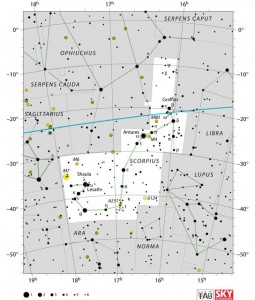July double star of the month – Nu Scorpii (ν Sco)
by Dave Blane
Two degrees east of beta Scorpii is a great multiple system to examine under high power on nights of good seeing. At low power, nu looks like a wide pair of stars with magnitudes 4.5 and 6.5 but closer examination reveals a more interesting system.
The American astronomer Ormsby M. Mitchel (who would later become a decorated Civil War general) observed nu Scorpii in 1846 with the 11-inch refractor at the Cincinnati Observatory. He was able to split the fainter star into its magnitude 6.6 and 7.2 components, which were 1.1 arc-seconds apart at the time. In 1873, the eagle-eyed double star observer S. W. Burnham detected the duplicity of the brighter star when its magnitude 4.4 and 5.3 components were a mere 0.3 arc-seconds apart. This was an amazing visual accomplishment, as Burnham made the discovery using a 6-inch refractor!
In the ensuing decades, these two pairs (designated Mitchel 2 and Burnham 120) widened and, by the early 1900s, were within reach of medium aperture scopes. In 1905, Agnes Clerke wrote that nu Scorpii is “perhaps the most beautiful quadruple group in the heavens.” Other astronomers likened it to the better-known “Double-double” epsilon (ε) Lyrae.
Today, the two binary stars that comprise the nu Scorpii system are wider than ever – 2.4 arc-seconds for Mitchel 2 and 1.3 arc-seconds for Burnham 120.
The brighter group, Nu Scorpii A and B, is composed of spectral type B2 sub-giants and the fainter pair, C and D, are spectral type B8 and B9 main sequence dwarfs. Nu Scorpii A is itself a semi-detached spectroscopic binary, having a fainter B-type companion separated by approximately 0.3 mas.
Although the system is high overhead on July evenings, optimum seeing conditions are a must, and you’ll need a telescope of at least 100mm aperture with good optics and a 200x-plus magnification.
Sketch of nu Scorpii
Was Agnes Clerke’s assessment of nu Scorpii accurate? Does it actually outrank the celebrated epsilon Lyrae in visual splendour? You won’t know unless you give each a telescopic examination.
Finder chart for nu Scorpii


